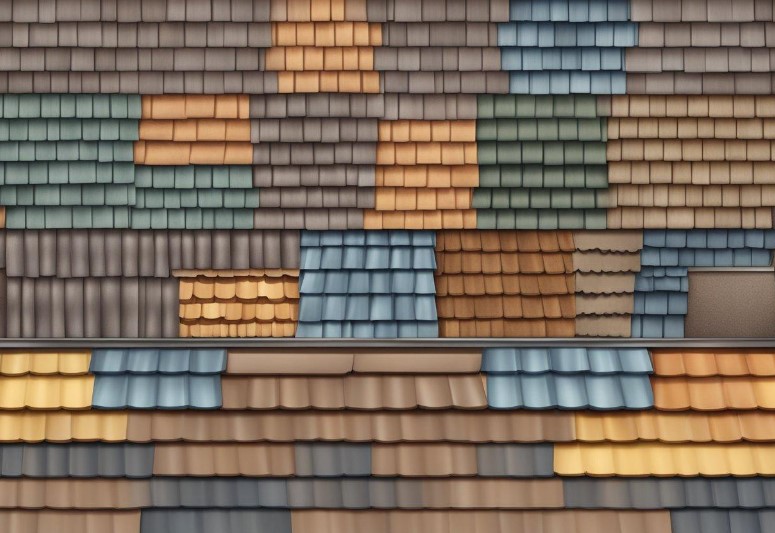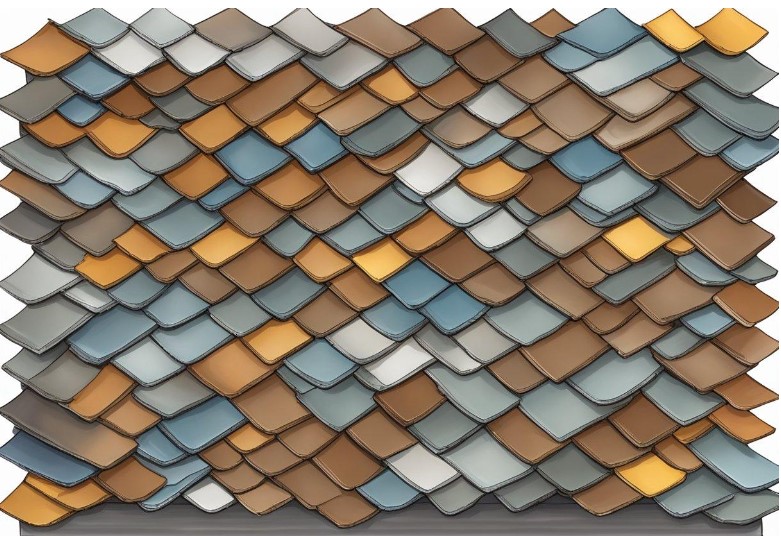Understanding the Unique Benefits of Different Roofing Materials
Different roofing materials offer unique benefits that cater to specific needs and preferences. Understanding these benefits can help homeowners make informed decisions when it comes to selecting the right roofing material for their homes. This article provides an overview of the advantages of various roofing materials commonly used in residential properties.
Asphalt shingles are the most popular roofing material in the United States due to their affordability, durability, and ease of installation. They come in a variety of colors, styles, and textures, allowing homeowners to customize the appearance of their roofs. Metal roofs, on the other hand, are known for their longevity and energy efficiency. They reflect sunlight and heat, which can reduce cooling costs during hot summer months. Tile roofs are renowned for their aesthetic appeal and durability. They are available in various shapes, sizes, and colors, and can withstand harsh weather conditions. Understanding the unique benefits of these materials can help homeowners choose the right option for their specific needs.
Overview of Roofing Materials
Roofing materials play a crucial role in protecting homes and buildings from the elements. There are a variety of materials available, each with its own unique benefits. Understanding the differences between these materials can help homeowners and building owners make informed decisions about which material is best for their needs.

Asphalt Shingles
Asphalt shingles are a popular roofing material due to their affordability and durability. They are made from a fiberglass mat that is coated with asphalt and ceramic granules. Asphalt shingles come in a range of colors and styles, making them a versatile option for many homes and buildings.
Metal Roofing
Metal roofing is a durable and long-lasting option that is resistant to fire, wind, and hail. It is available in a variety of materials, including steel, aluminum, and copper. Metal roofing is also environmentally friendly, as it can be recycled at the end of its life.
Clay and Concrete Tiles
Clay and concrete tiles are a popular roofing material in areas with hot and dry climates. They are durable and long-lasting, with a lifespan of up to 50 years. Clay and concrete tiles are also energy-efficient, as they help to keep homes and buildings cool by reflecting sunlight.
Slate
Slate is a natural stone that is known for its durability and longevity. It is a popular option for historic buildings and high-end homes. Slate is also fire-resistant and environmentally friendly, as it is a natural material that can be recycled at the end of its life.
Wood Shingles and Shakes
Wood shingles and shakes are a popular option for homes and buildings with a rustic or natural aesthetic. They are made from cedar or redwood and are durable and long-lasting. However, they require regular maintenance to prevent rot and decay.
Overall, each roofing material has its own unique benefits. Homeowners and building owners should consider their specific needs and preferences when choosing a material for their roof.
Durability and Longevity
Roofing materials play a crucial role in protecting homes and buildings from the elements. There are a variety of materials available, each with its own unique benefits. Understanding the differences between these materials can help homeowners and building owners make informed decisions about which material is best for their needs.

Asphalt Shingles
Asphalt shingles are a popular roofing material due to their affordability and versatility. They are made from a combination of asphalt and fiberglass, which makes them lightweight and easy to install. Asphalt shingles can last up to 20 years, but their lifespan can be affected by factors such as climate, proper installation, and maintenance. Regular inspections and repairs can help extend the lifespan of asphalt shingles.
Metal Roofing
Metal roofing is known for its durability and longevity. It is made from a variety of materials, including aluminum, steel, and copper. Metal roofs can last up to 50 years or more, depending on the quality of the material and installation. They are also resistant to fire, wind, and hail damage, making them a popular choice for areas prone to severe weather conditions.
Slate Tiles
Slate tiles are a natural stone roofing material that is known for its durability and aesthetic appeal. They can last up to 100 years or more, making them a long-lasting investment for homeowners. Slate tiles are also resistant to fire, wind, and water damage, making them a popular choice for areas with extreme weather conditions.
Wood Shakes
Wood shakes are a roofing material made from split logs. They are known for their natural beauty and rustic charm. However, they are also prone to rot, mold, and insect damage, which can affect their lifespan. Proper installation and maintenance can help extend the lifespan of wood shakes, but they typically last up to 30 years. Homeowners should consider the climate and maintenance requirements before choosing wood shakes as a roofing material.
Overall, the durability and longevity of a roofing material are important factors to consider when choosing a new roof. Homeowners should choose a material that is suitable for the climate and weather conditions in their area and invest in proper installation and maintenance to ensure a long lifespan.
Energy Efficiency
Reflective Coatings
Reflective coatings are a popular choice for homeowners who are concerned about energy efficiency. These coatings are designed to reflect sunlight and heat away from the roof, which can help to reduce the amount of energy needed to cool the home. Reflective coatings can be applied to a variety of roofing materials, including asphalt shingles, metal roofs, and flat roofs.
One of the benefits of reflective coatings is that they can help to extend the lifespan of the roof by reducing the amount of heat that is absorbed by the roofing material. This can help to prevent damage from UV rays and other environmental factors that can cause the roof to deteriorate over time.
Green Roofs
Green roofs are another option for homeowners who are looking to improve the energy efficiency of their home. These roofs are covered in vegetation, which can help to reduce the amount of heat that is absorbed by the roof. Green roofs can also help to reduce the amount of stormwater runoff that is generated by the roof, which can help to prevent flooding and erosion.
One of the benefits of green roofs is that they can help to improve the air quality in the surrounding area by absorbing pollutants and producing oxygen. Green roofs can also help to provide insulation, which can help to reduce the amount of energy needed to heat and cool the home.
Clay Tiles
Clay tiles are a popular choice for homeowners who are looking for a durable and energy-efficient roofing material. These tiles are made from natural clay, which can help to regulate the temperature of the home by absorbing and releasing heat as needed. Clay tiles are also resistant to UV rays and other environmental factors that can cause other roofing materials to deteriorate over time.
One of the benefits of clay tiles is that they can help to reduce the amount of energy needed to heat and cool the home by providing insulation. Clay tiles are also fire-resistant, which can help to reduce the risk of damage from wildfires and other natural disasters.
Cost Considerations
Initial Investment
When considering roofing materials, it is important to take into account the initial investment required for each option. Some materials, such as asphalt shingles, are relatively inexpensive and widely available, making them a popular choice for homeowners on a budget. On the other hand, materials such as slate or metal roofing can be significantly more expensive upfront, but may offer greater durability and longevity.
Maintenance Expenses
In addition to the initial investment, homeowners should also consider the ongoing maintenance expenses associated with different roofing materials. For example, some materials may require regular inspections and repairs to prevent leaks or damage from weather events. Others may be more resistant to wear and tear, reducing the need for frequent maintenance. It is important to factor in these costs when choosing a roofing material, as they can add up over time.
Replacement Costs
Finally, homeowners should consider the potential costs of replacing their roof in the future. While some materials may last for decades, others may need to be replaced more frequently due to wear and tear or damage from weather events. It is important to choose a material that offers a balance between durability and affordability, taking into account the potential costs of replacement down the line.
Overall, while cost is an important factor to consider when choosing a roofing material, it should not be the only consideration. Homeowners should also take into account factors such as durability, maintenance requirements, and aesthetic appeal when making their decision.
Aesthetic and Architectural Impact
Color and Texture Variety
The choice of roofing material can greatly impact the overall look and feel of a building. Different roofing materials come in a wide range of colors and textures, allowing for customization to match the aesthetic of the building and surrounding environment.
For example, cedar shingles offer a natural, rustic look with varying shades of brown and red. Clay tiles provide a classic, Mediterranean feel with their reddish-brown color and curved shape. Metal roofs come in a variety of colors and finishes, from sleek silver to bold red, and can be customized to fit modern or traditional styles.
Historical Styles
Roofing materials can also play a significant role in the historical style of a building. For instance, slate tiles were commonly used in the 19th century for traditional Victorian-style homes. Cedar shingles were popular in the early 20th century for craftsman-style homes.
Using the appropriate roofing material can help to maintain the historical integrity of a building, while also providing the necessary protection from the elements.
Modern Designs
In addition to historical styles, roofing materials can also be used to create modern and contemporary designs. Flat roofs with a membrane covering, for example, offer a sleek and minimalistic look often seen in modern architecture. Metal roofs can also be used to create a modern, industrial feel.
The variety of roofing materials available allows for endless possibilities in design and customization, making it easy to find the perfect fit for any building.
Regional Suitability
Cold Climates
When it comes to roofing materials, the suitability of a particular material varies according to the region. For instance, in cold climates, where there is a lot of snow and ice, metal roofing is a popular choice. This is because metal roofs are durable and can withstand the weight of heavy snow and ice. Additionally, metal roofs can help to prevent ice dams from forming on the roof, which can cause significant damage to the roof.
Another popular roofing material for cold climates is asphalt shingles. These shingles are affordable and easy to install, making them an excellent choice for homeowners on a budget. However, they may not be as durable as metal roofs, and they may require more maintenance over time.
Wet Environments
In wet environments, such as areas with high rainfall or humidity, it is essential to choose a roofing material that can withstand moisture and prevent water damage. One popular option for wet environments is clay tile roofing. These tiles are durable and can last for many years, even in wet conditions. Additionally, they are fire-resistant and can help to keep the home cool in hot weather.
Another suitable roofing material for wet environments is slate. Slate roofs are incredibly durable and can last for many years without needing repairs. Additionally, they are fire-resistant and can help to prevent water damage to the home.
High Wind Areas
In areas with high winds, it is essential to choose a roofing material that can withstand strong gusts and prevent damage to the home. One popular option for high wind areas is metal roofing. Metal roofs are incredibly durable and can withstand winds of up to 140 miles per hour. Additionally, they are fire-resistant and can help to prevent damage from falling debris.
Another suitable roofing material for high wind areas is concrete tile. These tiles are heavy and can withstand strong winds without becoming dislodged. Additionally, they are fire-resistant and can help to keep the home cool in hot weather.
Overall, when choosing a roofing material, it is important to consider the unique benefits and suitability for the region. By selecting the right material, homeowners can ensure that their roofs will last for many years and provide adequate protection for their homes.
Environmental Impact
Recyclable Materials
When it comes to the environmental impact of roofing materials, one important factor to consider is whether they can be recycled. Many roofing materials, such as asphalt shingles, cannot be recycled and end up in landfills after they are replaced. However, there are several roofing materials that are recyclable, including metal, clay tiles, and some types of synthetic materials.
Metal roofing, for example, is often made from recycled materials and can be recycled again at the end of its lifespan. Clay tiles are also recyclable and can be crushed down and used as fill material or as a base for roads. Synthetic materials, such as rubber and plastic, can also be recycled and turned into new roofing materials or other products.
Sustainable Production
Another important factor to consider is the sustainability of the production process. Some roofing materials require a lot of energy and resources to produce, which can have a negative impact on the environment. However, there are also many roofing materials that are produced using sustainable methods and materials.
For example, some manufacturers use recycled materials to produce their roofing products, which reduces the amount of waste that ends up in landfills. Others use renewable energy sources, such as solar or wind power, to power their production facilities. Additionally, some roofing materials, such as clay tiles, are produced using natural materials that are abundant and easy to source.
Overall, choosing roofing materials that are recyclable and produced using sustainable methods can help reduce the environmental impact of a building. By considering these factors, builders and homeowners can make informed decisions about the materials they use for their roofs.
Installation and Repair
Professional vs. DIY
When it comes to installing or repairing a roof, homeowners may be tempted to take a do-it-yourself approach to save money. However, it’s important to consider the potential risks and challenges before starting such a project. Installing or repairing a roof requires specialized skills and tools that most homeowners do not possess. In addition, DIY projects may not be covered by warranties or insurance policies, which could lead to costly mistakes.
Hiring a professional contractor is often the best choice for ensuring a quality installation or repair. Professional contractors have the experience and expertise needed to properly install or repair a roof, and they also have access to the necessary tools and materials. They are also licensed and insured, which provides homeowners with added protection.
Availability of Contractors
The availability of professional roofing contractors can vary depending on the region and time of year. During peak seasons, such as spring and summer, contractors may have a backlog of projects and may not be able to start new ones for several weeks or even months. Homeowners should plan accordingly and schedule their roofing projects well in advance.
In some areas, finding a qualified roofing contractor can be a challenge. Homeowners should research local contractors and check their credentials before hiring them. They should also ask for references and read online reviews to ensure that the contractor has a good reputation.
Common Repair Issues
Roofs can experience a variety of problems over time, including leaks, missing or damaged shingles, and structural damage. It’s important to address these issues promptly to prevent further damage to the roof and the home.
Some common repair issues can be fixed by homeowners themselves, such as replacing a few missing or damaged shingles. However, more complex repairs should be left to professional contractors. In addition, regular roof maintenance can help prevent many common repair issues from occurring in the first place. Homeowners should inspect their roofs regularly and address any issues as soon as they arise.
REACH OUT TO US
LET’S GET IN TOUCH
If you have any question regarding your roof, we encourage you to schedule an appointment or phone consultation with one of our roofing experts or visit our company. We are pleased to offer all types of roofing and siding services for the needs of your family or business.
OUR ADDRESS
Sudbury, Ontario
CALL US
+1 (705) 806 – 8570
EMAIL US
lorenz@sudbury-roofers.ca
